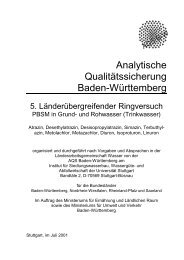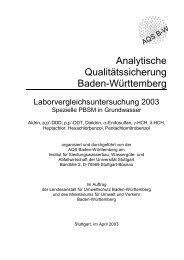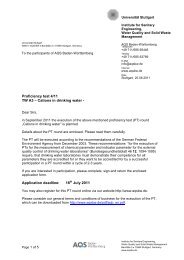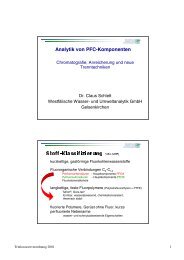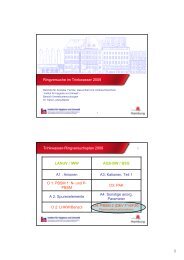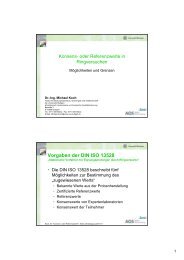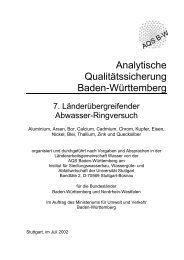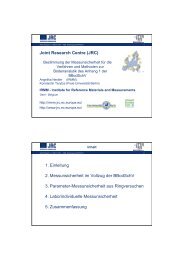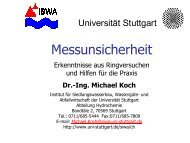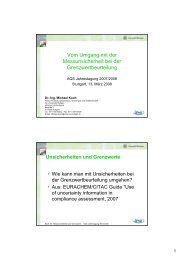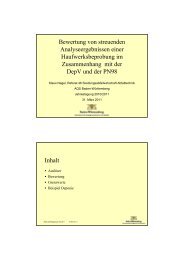Institute for Sanitary Engineering, Water Quality and Solid Waste ...
Institute for Sanitary Engineering, Water Quality and Solid Waste ...
Institute for Sanitary Engineering, Water Quality and Solid Waste ...
You also want an ePaper? Increase the reach of your titles
YUMPU automatically turns print PDFs into web optimized ePapers that Google loves.
Hydrochemistry CH<br />
Projects<br />
Flame retardants in organisms of Lake Constance<br />
(FLABO)<br />
The Lake Constance is an important habitat <strong>for</strong> fish <strong>and</strong><br />
there<strong>for</strong>e a large food resource - the fishing quota <strong>for</strong><br />
2008 was around 725 tones. Organic micro-pollutants,<br />
especially persistent lipophilic compounds enter Lake<br />
Constance <strong>and</strong> accumulate in the sediments, as well<br />
as in fish <strong>and</strong> shellfish.<br />
Typical representatives of these contaminants are polychlorinated<br />
biphenyls (PCBs) which were banned because<br />
of their toxic properties already over 20 years<br />
ago, but can still be detected in various environmental<br />
samples. Polybrominated diphenyl ethers (PBDEs)<br />
have been used since the 1970s as flame retardants<br />
in textiles <strong>and</strong> electrical housings <strong>and</strong> also showed rising<br />
environmental levels over the last few decades.<br />
Since the industry signed a voluntary negotiated agreement<br />
on production <strong>and</strong> application concentrations<br />
seem to have stagnated. The study of dated sediment<br />
cores from Lake Constance in 2004/2005 (Interreg III)<br />
showed an increase of PBDE-concentrations in younger<br />
sedimentary layers. Within the current project, the<br />
PBDEs compared to the group of PCBs were determinated<br />
in fish (bream - Abramis brama), zebra mussels<br />
(Dreissena polymorpha) <strong>and</strong> sediments of Lake<br />
Constance. The bream is a species of fish living close<br />
to the sediment partly feeding on zebra mussels. In<br />
addition obtaining in<strong>for</strong>mation on the present load, the<br />
aim was to have a closer look on substance accumulation<br />
along the food chain.<br />
The contaminants could be detected in all investigated<br />
environmental samples. The concentrations of PCBs in<br />
the sediments were at similar levels as in 2004/2005<br />
<strong>and</strong> are thereby lower than quality objectives of the<br />
WFD (20 micrograms / kg dry matter). On examination<br />
of the upper layers lower concentration levels than<br />
in the older deeper layers could be determinated. The<br />
PCB concentrations in the mussels were at small levels<br />
similar to those in the sediment. The congener pattern<br />
(concentration distribution of the various individual<br />
compounds) showed similarities with the technical<br />
mixture „Chlophen-A60“. The pattern of the PBDEs<br />
also shows similarities with the technical penta-bromo<br />
diphenyl ether mixture. While the PCB pattern between<br />
the investigated environmental samples looked<br />
similar, the PBDE profile of the various samples were<br />
significantly different. This gives us an indication of<br />
specific uptake or degradation of certain PBDE congeners.<br />
The maximum PCB-concentrations found in the fillets<br />
of bream are far below the threshold limit <strong>for</strong> fresh<br />
water fish (Schadstoff-Höchstmengen Verordnung).<br />
Compared to PCB concentrations the PBDE concentrations<br />
are lower by an order of magnitude. Threshold<br />
limits do not exist <strong>for</strong> the group of PBDEs.<br />
Fig:<br />
Trip with the research ship of the <strong>Institute</strong> of Lake Research, Langenargen (LUBW) <strong>for</strong> sediment <strong>and</strong> mussel<br />
sampling.<br />
123




